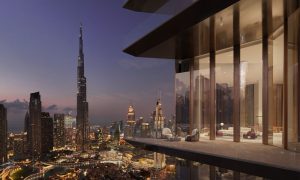Waiting for the whistle
Middle East Consultant finds out if Qatar is on course with its construction plans for the World Cup 2022

Last month, Qatari officials announced they have cut down the number of stadiums for the FIFA World Cup 2022 by a third. Now, eight stadiums will now be constructed – instead of the originally-planned 12 – to host the world’s most-watched football event.
While this decision has fuelled global critics who question Qatar’s capability to deliver its promises, Ruari Maybank, director at Atkins Qatar, is highly optimistic about the country hosting a world-class event in 2022.
“There are parallels that can be drawn from the challenges faced by London in the run-up to 2012, and how those can be used to target specific challenges in Qatar’s preparation for 2022,” says Maybank, who has previously worked with the government of UK on preparation and procurement processes for the London Olympic Games 2012.
“London 2012 was delivered, from bid to staging, in roughly seven years, and this timeframe is similar to what Qatar has in the run up to the event,” says Maybank. “The model for hosting the World Cup in Qatar is, in many ways, similar to the organisation of the Olympics.
“All stadiums and facilities related to Qatar 2022 are centered on a city rather than being spread around a large country, which is the model traditionally followed for World Cups. It wouldn’t be wrong, therefore, to expect the same logistical challenges from this event as we might have faced in preparation for London 2012.”
The ‘logistical challenges’ Maybank speaks of are many – for one, the Qatari market has to contend with economic factors, such as rapid population growth, reported material shortages and the threat of consequent price rises.
“The projects in the current market scenario are definitely driven by the government sector, but this could change in the years to come,” says Raj Achan, business development manager for Hilson Moran UAE. “There is huge potential for growth in Qatar, and it is an exciting time for new or foreign companies wishing to enter and compete in its construction market. I see scope for PPPs to be formed in the country.”
Irrespective of how it is driven, the scale of the delivery remains a challenge for the smallest country – in both, size and population – to have ever hosted a FIFA World Cup tournament.
Maybank draws from his experience with London 2012 to illustrate the enormity of the task Qatar has undertaken. “A challenge for Qatar will be to create, establish and maintain an infrastructural network that has the capacity to facilitate the event smoothly. London, on the other hand, already had established systems for transport, buildings, communication integration and so on, some of which even dated back to before the Victorian era.
“Qatar has to build its infrastructure, between roads, stadiums, airports and city centres for the first time; London only had to update its networks and ensure they functioned as per the requirement. Building this infrastructure in the run up to the World Cup 2022 presents an opportunity to get the infrastructure and operational systems right first time.”
Brazil’s preparations for the FIFA World Cup 2014 serve as a harsh reminder of the stringent discipline Qatar will have to employ while constructing for the World Cup 2022.
In November 2013, a collapsed crane claimed the lives of two workers on the construction site of the Itaquerão Stadium, which is due to host the opening ceremony in Sao Paulo this July. Unfortunately, this was only one of many setbacks faced by constructors of the stadium, who had by then, already dealt with time delays and increased costs since they began operations on-site in 2011. While funding may not be such as issue for Qatar, time certainly is – the testing of stadiums, roads, rail networks and all other major infrastructural developments can commence only after construction has been completed.
Maybank advocates the need for Qatar to set aside an ample duration to be able to review and, if needed, repair its ongoing and future infrastructure projects on completion. “A tenet for us while preparing for London 2012 was to complete all work a year in advance to have sufficient testing time for the facilities.
“The same is found to be the case in Qatar. To establish its infrastructure for the first time will be a challenge for the country’s authorities, but it is pleasing to see the effort taken by organisations such as Qatar Rail which is working to ensure it can test its services well before the event commences.”
Achan says the key for consultants is to have an understanding of the Qatari culture and the way of operation. He continues: “Smooth operations require that the client has excellent relations in the contractors and consultants it works with.
“Construction processes in Qatar may sometimes take longer when compared with, say, the UAE, but that is largely due to the fact that the Emirati market is more evolved than most its GCC counterparts are. In terms of legislation, the UAE market is probably 10 years ahead. Having said that, Qatar is definitely making the required amendments to ensure its Vision 2030 is optimally achieved, and the country is keen on keeping pace with the developments taking place in the rest of the Middle East region.”
While the oil- and gas-rich Qatar is capable of delivering the requirements internally, the country will also be relying on developments in neighbouring states to allow for the smooth inflows of labour, material and other resources. In the lead up to 2022, Dubai will have hosted the World Expo in 2020, and Etihad Rail – a network unifying all six GCC nations – is due to be operational in 2018.
“It is a remarkable facet of the GCC that events here build upon both the local culture of their hosts and incorporate the strengths of the region,” says Maybank. “This is a good sign for the World Cup 2022, as it ensures services such as transport, infrastructure and material handling are collaborated for better results.”
The question of pan-GCC cooperation assumes more importance given Qatar’s need to fix the shortages that currently puncture its supply market. Qatar’s cement industry, for instance, will have to ramp up its capacities to meet the future estimated demand in the country.
A report titled ‘GCC Cement Sector Quarterly – 3Q2013’ by Global Investment House, says estimates of cement demand for 2013 provided by government authorities (3.5 – 4.0 million tonnes per annum) are considerably lower than the market-estimated demand of 5.5 million tonnes per annum during 2013 – 2015.
Understandably, this figure is expected to further increase as large-scale projects in preparation for the World Cup 2022 move along, highlighting the need for appropriate procurement channels to facilitate the inflow and movement of construction materials across the country, presently served predominantly by its road network.
“The Qatari authorities will have to contend with issues such as how to move around material like cement and aggregates across the country through its road network, and to ensure a skilled workforce is created in the right numbers,” says Maybank.
He continues: “It needs an appropriate prioritisation of works to meet the needs of the event and the economy. This requires the establishment of a solid management system which allows authorities to collaborate and optimise their decision-making powers at the right level and time in a way that does not hinder event preparation.”
Despite the many challenges, Maybank remains positive that Qatar is more than up to the task of delivering what is needed. “To host the World Cup here will be an achievement to be proud of for Qatar. As an innovative country that has the intelligent manpower required to supplement such an event, I am confident Qatar will be a great host.”























